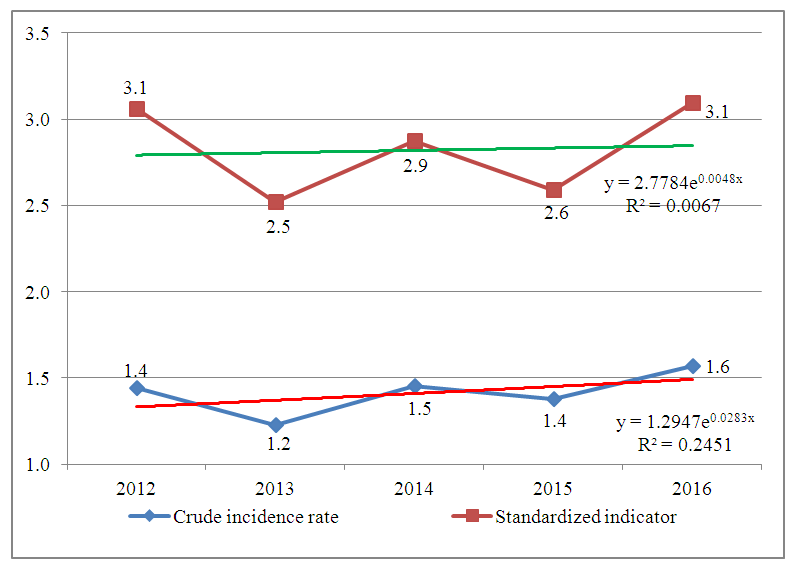-
Paper Information
- Next Paper
- Previous Paper
- Paper Submission
-
Journal Information
- About This Journal
- Editorial Board
- Current Issue
- Archive
- Author Guidelines
- Contact Us
American Journal of Medicine and Medical Sciences
p-ISSN: 2165-901X e-ISSN: 2165-9036
2018; 8(1): 333-335
doi:10.5923/j.ajmms.20180811.07

Dynamics and Forecast of Mortality of Prostate Cancer in the Republic of Uzbekistan
A. Tursunkulov, D. Alieva
Republican Clinical Hospital №1, MOH Uz Republican Specialized Scientific Practical Medical Center of Oncology and Radiology, Tashkent, Uzbekistan
Correspondence to: A. Tursunkulov, Republican Clinical Hospital №1, MOH Uz Republican Specialized Scientific Practical Medical Center of Oncology and Radiology, Tashkent, Uzbekistan.
| Email: |  |
Copyright © 2018 The Author(s). Published by Scientific & Academic Publishing.
This work is licensed under the Creative Commons Attribution International License (CC BY).
http://creativecommons.org/licenses/by/4.0/

This article represents the results of dynamic change of mortality rate of a prostate cancer in the Republic of Uzbekistan (crude and standardized indicators) for 2012-16y, mortality trends, the forecast for 2020y., their dynamic change.
Keywords: Prostate cancer, Republic of Uzbekistan, Mortality, Trend, Standardization, Dynamic observation
Cite this paper: A. Tursunkulov, D. Alieva, Dynamics and Forecast of Mortality of Prostate Cancer in the Republic of Uzbekistan, American Journal of Medicine and Medical Sciences, Vol. 8 No. 1, 2018, pp. 333-335. doi: 10.5923/j.ajmms.20180811.07.
1. Introduction
- The Prostate Cancer (PC) has been described for the first time in 1853 by the English surgeon J. Adams, i.e. historically this disease is known for many years, but until today the problems related to its diagnostics and treatment remain relevant [5, 7]. Studying of a disease from the point of view of an onco-epidemiology is important. In this article studying of rates of mortality of PC in dynamics in the Republic of Uzbekistan for 2012-16 is carried out. The PC incidence is different in all regions of the world, including racial distinctions are noted that causes various levels of rates of incidence and mortality of this pathology. This disease is considered the most widespread among black Americans - 2720/0000, at the same time incidence in residents of Southeast Asia – China is rather low – 1,90/0000. All this defines need of studying this pathology in the epidemiological aspect, in this connection mortality in the Republic of Uzbekistan is studied.Mortality rates also vary in the different countries of the world, for example, in Sweden this indicator it the highest in the world [2, 3, 6] and is the second most common cause of death in men, after death from cardiovascular diseases. At the same time standardization of rate of mortality at PC in breakdown by age shows its decrease for the last 15 years, at the same time the greatest decrease – 35% was observed among men younger than 75 years old that is associated with the fact that the number of elderly men among the population and life expectancy increase.
2. Materials and Methods
- For assessment of rates of mortality of PC in dynamics the data obtained from the State Committee of the Republic of Uzbekistan on statistics according to form 7-SSV, have been analyzed, processing of the received materials are carried out with use of the Microsoft Office2007: (Excel, Word, Access; statistics 0,6) programs.
3. Results and Discussions
- In this research studying of mortality rate in dynamics in the Republic of Uzbekistan for the 5-year period is carried out (2012-16.). In the general structure of mortality from the malignant neoplasms (MN) in 2016, PC took the 20th place, at the same time the crude indicator of mortality was – 0,80/0000, calculated for the number of male population, mortality has risen to the 7th rank place (253), and mortality rate made 1,60/0000, with the general mortality of 42,60/0000.In the analysis of age aspects of PC, average age of mortality of pathology was 73,7+0,40 years, 95% confidence interval (95% CI) – 72,9-74,5, at the same time the highest rate of mortality was noted in 2012 and made 75,8 years. Growth rate of mortality was the Rgr = +15,4%, the analysis of trends of mortality has shown their dynamic increase: 2012 - 67,2; 2013 – 80,2; 2014 – 93,2; 2015 – 106,2; 2016 – 119,2.Calculation of predictive age has shown that if this trend to mortality growth continued average age in 2020 will make 69,6 years.Also age-specific indicators at which the greatest average value of mortality was defined in group of PC patients at the age of 65 and older have been studied and it has made 28,2±0,920/0000, 95% CI 26,5-30,00/0000, and the smallest one in age of 15-44 years 0,48±0,0050/0000, 95% CI – 0,0-0,10/0000, the rate of a decrease Rdecr =-1,2%. At other age average values of mortality for the studied periods are also estimated and made: 18-44 years - 0,048-0,0060/0000, 95% CI 0,0-0,0060/0000, Rgr = +8,4%; 45-64 years 2,4±0,10/0000, 95% CI 2,2-2,70/0000, Rgr = +9,2%; (tab.1)
|
 | Figure 1. Crude and standardized PC mortality in the Republic of Uzbekistan for 2012-16 |
 | Figure 2. Calculation of estimated rate of PC mortality in the Republic of Uzbekistan for 2020 |
4. Conclusions
- The leading causes of mortality which increase its level at PC most likely are the reasons associated with the insufficient level of diagnostics that leads to a large number of the patients overflowing specialized institutions at widespread stages of process as well as system generalization.The main practical result of this epidemiological research is the calculation of the standardized indicators allowing to carry out comparative studying and also a calculation of trends of determination of growth/decrease rates and predictive indicator. It allows to define and estimate the possible social and economic damage caused by increase in an indicator of mortality of this pathology that is necessary when forming national programs of fight against malignant neoplasms, developing programs of screening, early diagnostics that is especially important for male population of working-age.
 Abstract
Abstract Reference
Reference Full-Text PDF
Full-Text PDF Full-text HTML
Full-text HTML